Thedialogutility is used tocreatea basic-level graphical user interface. We can use this in shell script to create very useful programs.
To install thedialogutility in Debian or Ubuntu Linux, enter the following command:
$ sudo apt-get update
$ sudo apt-get install l dialogSimilarly, enter the following command to install the utility dialog in CentOS or Red Hat Linux:
$ sudo yum install dialogThe typical syntax of thedialogcommand is as follows:
$ dialog --common-options --boxType "Text" Height Width --box-specific-optionThecommon-optionsutility is used to set the background color, title, and so on in dialog boxes.
The option details are as follows:
Text: The caption or contents of the boxHeight: The height of the dialog boxWidth: The width of the dialog box
Creating a message box (msgbox)
Tocreatea simple message box, we can use the following command:
$ dialog --msgbox "This is a message." 10 50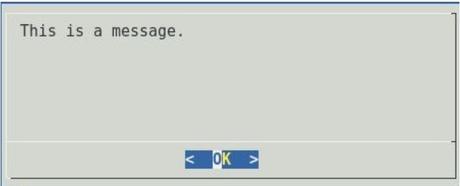
Creating a message box (msgbox) with a title
Enter the following command to create a message box with the following title:
$ dialog --title "Hello" --msgbox 'Hello world!' 6 20The option details are as follows:
--title "Hello": This will set the title of the message box to"Hello"--msgbox 'Hello world!': This will set the content of the message box to"Hello world!"6: This will set the height of the message box20: This will set the width of message box:
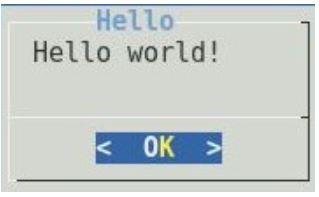
The message box has a Hello title with content Hello World! It has a single OK button. We can use this message box to inform the user about any events or information. The user will have to press Enter to close this message box. If the content is large for a message box, then the dialog utility will provide the scrolling of the message.
The yes/no box (yesno)
If we need to obtain a yes or no answer from the user, we can use the following options along with the dialog command:
$ dialog --yesno "Would you like to continue?" 10 50
We can have the same yes/no dialog box with a title as follows:
$ dialog --title "yesno box" --yesno "Would you like to continue?" 10 50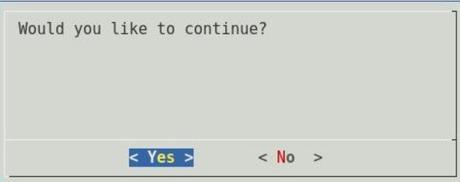
Let’s write the dialog_01.sh shell script as follows:
dialog_01.sh
#!/bin/bash
dialog --title "Delete file"
--backtitle "Learning Dialog Yes-No box"
--yesno "Do you want to delete file "~/work/sample.txt"?" 7 60
# Selecting "Yes" button will return 0.
# Selecting "No" button will return 1.
# Selecting [Esc] will return 255.
result=$?
case $result in
0) rm ~/work/sample.txt
echo "File deleted.";;
1) echo "File could not be deleted.";;
255) echo "Action Cancelled - Presssed [ESC] key.";;
esac Let’s test the following program:
$ chmod +x dialog_01.sh
$ ./dialog_01.shOutput:
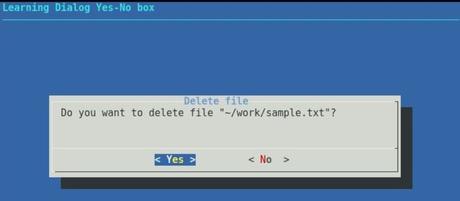
The input box (inputbox)
Whenever we want to ask a user to input text via the keyboard, in such situations, the inputbox option is useful. While entering text via the keyboard, we can use keys such as Delete, Backspace, and the arrow cursor keys for editing. If the input text is larger than the input box, the input field will be scrolled. Once the OK button is pressed, the input text can be redirected to a text file:
# dialog --inputbox "Please enter something." 10 50 2> /tmp/tempfileVAR=`cat ~/work/output.txt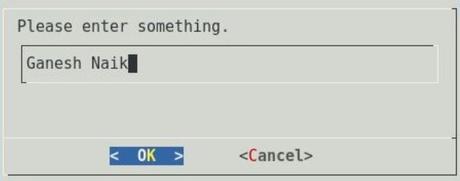
Let’s write the dialog_02.sh shell script to create an input box as follows:
dialog_02.sh
#!/bin/bash
result="output.txt"
>$ $result # Create empty file
dialog --title "Inputbox Demo"
--backtitle "Learn Shell Scripting"
--inputbox "Please enter your name " 8 60 2>$result
response=$?
name=$(<$result)
case $response in
0) echo "Hello $name"
;;
1) echo "Cancelled."
;;
255) echo "Escape key pressed."
esac
rm $result Let’s test the following program:
$ chmod +x dialog_02.sh
$ ./dialog_02.sh
Output:
Output:
"Hello Ganesh Naik"The textbox (textbox)
If we want to display the contents of the file in a textbox inside the menu created by a dialog, then enter the following command:
$ dialog --textbox /etc/passwd 10 50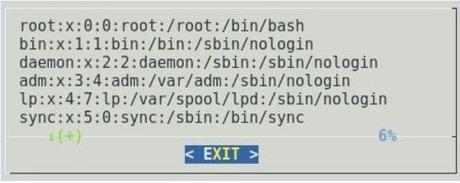
We are displaying the /etc/passwd file in the textbox with the previous command.
A password box
Many times, we need a password from the user. In this case, the passwordshouldnot be visible on the screen. The password box option is perfect for this purpose.
If we want to display an entered password as a string of****, then we will need to add the--insecureoption.
We will need to redirect the inserted password to a file.
Let’s write dialog_03.sh shell script to receive the password as follows:
dialog_03.sh
#!/bin/bash
# creating the file to store password
result="output.txt 2>/dev/null"
# delete the password stored file, if program is exited pre-maturely.
trap "rm -f output.txt" 2 15
dialog --title "Password"
--insecure
--clear
--passwordbox "Please enter password" 10 30 2> $result
reply=$?
case $reply in
0) echo "You have entered Password : $(cat $result)";;
1) echo "You have pressed Cancel";;
255) cat $data & [ -s $data ] || echo "Escape key is pressed.";;
esac Let’s test the following program:
$ chmod +x dialog_03.sh
$ ./dialog_03.shOutput:
Output:
You have entered Password : adcd1234The checklist box (checklist)
In this case, we can present the user with a choice to select one or multiple options from a list:
# dialog --checklist "This is a checklist" 10 50 2
"a" "This is one option" "off"
"b" "This is the second option" "on" 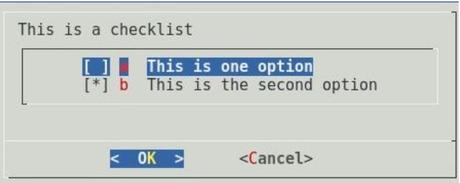
The menu box (menu)
Usually, a program or shell script may berequiredto perform multiple types of tasks. In such cases, the menu box option is very useful. This option will display a list of choices for the user. Then, the user may select an option of their own choice. Our script should execute the desired option.
Each menu has two fields, a tag and an item string. In the next example menu demo, we have tags such as date, calendar, and editor. A description of a tag is called an item string.
Let’s write the dialog_04.sh shell script to create a menu as follows:
dialog_04.sh
#!/bin/bash
# Declare file to store selected menu option
RESPONSE=menu.txt
# Declare file to store content to display date and cal output
TEMP_DATA=output.txt
vi_editor=vi
# trap and delete temp files
trap "rm $TEMP_DATA; rm $RESPONSE; exit" SIGHUP SIGINT SIGTERM
function display_output(){
dialog --backtitle "Learning Shell Scripting" --title "Output" --clear --msgbox "$(<$TEMP_DATA)" 10 41
}
function display_date(){
echo "Today is `date` @ $(hostname -f)." >$TEMP_DATA
display_output 6 60 "Date and Time"
}
function display_calendar(){
cal >$TEMP_DATA
display_output 13 25 "Calendar"
}
# We are calling infinite loop here
while true
do
# Show main menu
dialog --help-button --clear --backtitle "Learn Shell Scripting"
--title "[ Demo Menubox ]"
--menu "Please use up/down arrow keys, number keysn
1,2,3.., or the first character of choicen
as hot key to select an option" 15 50 4
Calendar "Show the Calendar"
Date/time "Show date and time"
Editor "Start vi editor"
Exit "Terminate the Script" 2>"${RESPONSE}"
menuitem=$(<"${RESPONSE}")
# Start activity as per selected choice
case $menuitem in
Calendar) display_calendar;;
Date/time) display_date;;
Editor) $vi_editor;;
Exit) echo "Thank you !"; break;;
esac
done
# Delete temporary files
[ -f $TEMP_DATA ] & rm $TEMP_DATA
[ -f $RESPONSE ] & rm $RESPONSE Let’s test the following program:
$ chmod +x dialog_04.sh
$ ./dialog_04.shOutput:
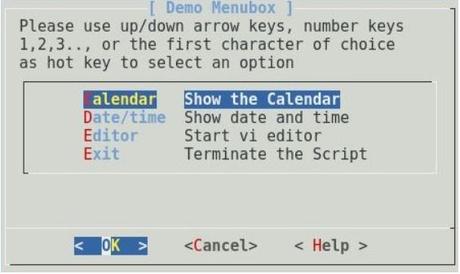
The radiolist box (radiolist)
If you want the user to select only one option out of many choices, then radiolist is a suitable option:
# dialog --radiolist "This is a selective list, where only one
option can be chosen" 10 50 2
"a" "This is the first option" "off"
"b" "This is the second option" "on" Radio buttons are not square but round, as can be seen in the following screenshot:
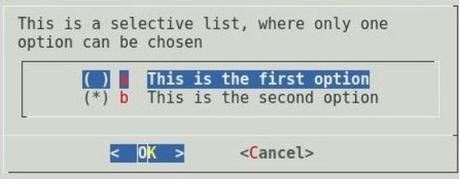
The progress meter box (gauge)
The progress meter displays a meter at thebottomof the box. This meter indicates the percentage of the process completed. New percentages are read from standard input, one integer per line. This meter is updated to reflect each new percentage.
Let’s write the dialog_05.sh shell script to create a progress meter as follows:
dialog_05.sh
#!/bin/bash
declare -i COUNTER=1
{
while test $COUNTER -le 100
do
echo $COUNTER
COUNTER=COUNTER+1
sleep 1
done
} | dialog --gauge "This is a progress bar" 10 50 0Let’s test the following program:
$ chmod +x dialog_05.sh
$ ./dialog_05.shOutput:
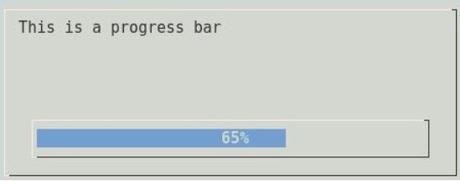
Customization of dialog with the configuration file.
We can customize dialog using the~/.dialogrcconfiguration file. The default file location is$HOME/.dialogrc.
To create the.dialogrcconfiguration file, enter the following command:
$ dialog --create-rc ~/.dialogrcWe can customize the output of the dialog utility by changing any of the configuration parameters defined in the .dialogrc file.
